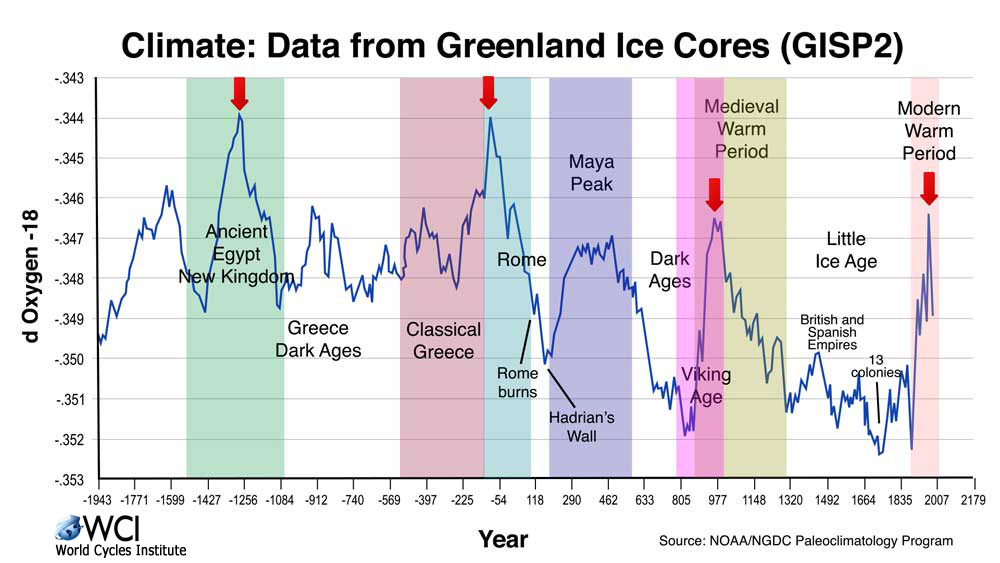 Social Traits for this Cycle Turn: Cool is Good, Hot is Not
Social Traits for this Cycle Turn: Cool is Good, Hot is Not
Originally published March 8, 2021
Major tops typically produce at least a 25-35 year transition period. We’re moving through a 1,030 year cycle top, from a warm-dry climate to a cold-dry climate. If you consider that the climate high was in 1998, then we have about another ten years before colder climate becomes much more obvious.

(Above is a chart developed from data from the GISP2 ice core project delivered in the early 1990s). The red arrows denote the tops of one thousand year climate cycles (these are temperature highs, identified by the blue line). The red arrow cycle tops also mark the tops of major civilizations.
When it is warm and wet, civilizations grow and thrive. When it turns cold and dry, they dissolve and we enter a “dark age.” This has happened over and over again throughout recorded history. We’re currently at the hot-dry turn of the American Empire into a colder-dry period that will last hundreds of years.
This drop in temperature typically lasts 500 years. The temperature only drops a few degrees centigrade over that period, so that in 500 years, we might have summers that are as much as ten degrees colder (centigrade) than we’re used to. It affects the growing season and the food supply. Lower levels of nourishment affect health, so that’s when we see more disease (and pandemics) historically. That was the major clue in my calling this COVID bug a “false flag” last March; the timing was wrong, which suggested it was other than natural.
You can think of these changing climate cycles as “seasons,” but with much longer timeframes. When these changes in temperature occur, we see changes all through society, not just in climate. This has led me over the years I’ve been working with cycles in trying to find the “missing link,” as it were. Dr. Wheeler thought is was climate that caused all the social changes that manifest themselves each time we go into a new major cycle. Other cycle luminaries, like Edward Dewey, thought otherwise. I believe we’re affected by electromagnetic waves from the Moon and the planets in our solar system.
The stock market itself moves in cycles; it moves in a predictable pattern of five wave to denote a trend and three waves for corrections to that trend (partially retracing the previous five wave pattern). The wave lengths adhere to fibonacci ratios, primarily the golden mean (1.618). The market moves through the same corrective patterns (triangle, flats, and zigzags) over and over and over again. It’s as if it were programmed.
It’s people who are the ones who trade the stock market, of course, but the influence is obvious at particular times, for example, anytime there’s a full moon. There are many traders that trade the market based upon the movement of the planets alone.
So, where does this predictable movement come from? Well, it’s a bit of a secret, but if you were to take the distances between the planets in our solar system and average them, you’d find that they come to 1.618.
The Universe, and hence our world, runs on math.
When the markets at a high, the social mood is positive, when at a low, just the opposite is true. We’re at a high now and very soon, we’re going to see a turn to the downside that will end in a precipitous drop. The mood will turn decidedly negative.

There’s so little research that’s been done in this area of how low-frequency electormagnetic waves influence us psychologically, but I was buoyed in the past two days to find the work of Joseph Kirschvink, and I’m going to follow up. Joseph L. Kirschvink is an American geologist and geophysicist, known for contributions to paleomagnetism and biomagnetism and the Snowball Earth hypothesis. He is also Principal Investigator of Earth–Life Science Institute. The diagram above showcases some of his work in this area. Some years ago, I produced a short video to highlight my thinking along this line, and titled it “Puppets on a String?”
Mr. Kirschvink’s work confirms my thinking that the traits that seem to affect human across the world coincidentally are indeed caused by the influence of the planets. This also supports the idea that there is truth to astrology. Perhaps we should be giving our ancestors a lot more credit for their focus on the Universe each time they decided what path to take in their lives!
Keep that in mind as I list many of the traits that we see in both hot-dry periods and cold dry periods. We’re currently moving from the former to the latter. Gradually, you’re going to see the cold-dry traits take over.
General traits of a cold-dry period:
- anarchism,
- financial depression,
- inadequate government,
- weak leaders,
- civil wars rather than international wars,
- mass migration,
- pandemics, and
- class revolution.
Here are some of the changes you can expect as we move from the warm dry climate of the late 20th century through the current wet-cool short cusp to the cooler dryer climate of the next several hundred years (from the research of Dr. Ralph H. Wheeler):
| Warm Dry Period We’re Leaving | Cold Wet Period We’re Entering |
|---|---|
| dictatorships (too much gov’t) | democratization (insufficient gov’t) |
| imperialism (rising national spirit) | cosmopolitanism (falling national spirit) |
| expansion/annexation | migrations/less organized invasions |
| world wars (strong vs. strong) | civil wars (strong against weak) |
| national fascism, totalitarianism | anarchy, freedom of individual |
| federal rights | individual rights |
| long reigns, good rulers (early warm) | short reigns, poor rulers |
| growth of cities | move from city to country |
| rising prices (inflation) | falling prices (deflation) |
| increase in luxuries | decrease in luxuries |
| less prostitution (early warm) | increase in prostitution, abnormal sexual behavior |
| Golden Age (early warm) | Dark Age |
| increase in religious regulation | personal orthodoxy |
| neglect of grammar | attention to grammar, lexicographers |
| abstract harmony and melody | simple melody, folks songs |
| fashion: simple, plain, dignified | turns complex, ornate, elaborate |
| high birth rate to low birth rate (late warm) | low birth rate |
| learning by discovery | learning by drill |
| idealism (philosophy) | hedonism |
| manufactory expansion | agricultural expansion |
| polite comedy in literature | vulgar comedy |
| culture: aristocratic, refined, profound (early warm) | move to plebian, vulgar, superficial |
| art: emphasis on abstract form and line | complexity, ornateness, stiff, crude |




Very informative, and interesting. I will pay it Forward like the movie!!!
Anything on Crypto cycles? Looks to me that as Faith in government falls crypto rises. Also the renegades think they are going against the central bankers when the hunt for taxes is what this digital wallet currency entails. I had a friend that patent the electronic purse years ago cited by the Federal Reserve. If implemented properly it would have made us all independent private bankers. Recently their was report that Google has a AI so advanced that it can break the 512 encryption. That means it can take over the Bitcoin markets. I got that from Mike Adams website whom i have a tendency to trust.
Thank You Peter!!!
Hi Chris,
I post the Elliott Wave analysis of the NYSE Bitcoin index, from time to time. It appears to be moving with the larger market. The waves up from the bottom are in a zigzag pattern, which is corrective and means it will eventually drop right back down to the bottom. However, it may have up to a year before it tops. In any event, I don’t give it a long life.